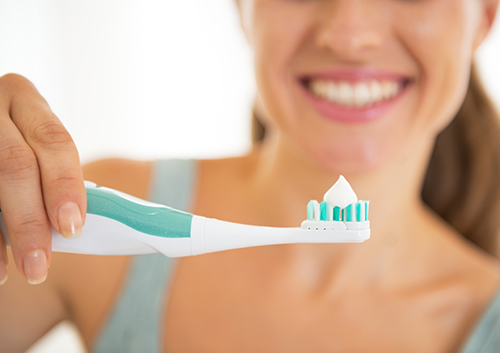
X-rays are a vital diagnostic tool for any dental professional. X-rays help your endodontist perform a root canal, your orthodontist check the position of a tooth’s root, your oral surgeon discover a fracture. X-rays reveal what we can’t see with the naked eye—and that’s why they are an especially important tool for Dr. Jenny A. Kanganis as well.
Why Are X-rays Necessary?
There’s a lot going on below the surface. An X-ray can reveal such conditions as cavities between teeth or underneath fillings, abscesses and other infections in the bone, impacted wisdom teeth, and cysts and tumors. They can also show the size, shape, and density of the bone beneath the teeth, which is essential information for dental implant procedures or dentures.
How Do X-rays Work?
Traditional X-rays, or radiographs, make use of film just like traditional cameras. When you have an intraoral X-ray, for example, the film is sealed in a moisture- and light-proof packet, and placed inside the mouth to capture images of specific teeth and the bone around them.
The X-ray machine is aligned precisely with the film and an exposure is taken. The image at this point is latent, and won’t show on the film, because, just like photo film, traditional radiographs need to be chemically processed before they produce a visible image.
Digital technology, on the other hand, uses an electronic sensor instead of film. For an intraoral digital X-ray, a small sensor is positioned in the mouth just like a film. When the X-ray is taken, a digital image capture device produces an image which is formed by a matrix of pixels instead of a photo-like film exposure. This format allows the image to be sent directly to a computer for immediate display without requiring processing.
Even though these methods seem very similar, digital X-rays offer some significant advantages over traditional films. Let’s look at how they compare, more or less.
A traditional X-ray is a fixed image. It cannot be modified or enhanced. Here the digital X-ray offers a clear advantage in diagnosis.
Just as you can enlarge certain types of images on your computer without blurring or losing detail, a digital X-ray uses computer software to magnify images while keeping their details sharp. They can also be enhanced through brightness and contrast applications to make details stand out even more. Both of these benefits are extremely helpful for diagnosis, especially when looking for small cavities, problems in the roots and surrounding bone, or developing wisdom teeth.
There is even digital subtraction radiography software available that can be used to compare recent images to older ones, removing (“subtracting”) all the similarities in the two images to display only the changes in the two—even small changes—that have taken place over time.
Dental X-rays expose patients to very low levels of radiation, and modern technology means traditional X-rays expose patients to less radiation than ever before. Even so, digital X-rays have significant advantages. Radiation exposure can be reduced by an additional 10%, 20%, or more with a digital radiograph.
If you need to share your X-rays with another dental specialist or physician, digital technology allows you to simply have them e-mailed to another office or multiple offices. You no longer need to worry about preserving physical copies, either.
Unlike traditional X-rays, digital X-rays don’t need to be processed, so you save time in the office. And while the processing time is not significant (usually several minutes), if you need to repeat some X-rays for a clearer picture, or require different images for several teeth, this time can add up.
Digital X-rays are also more eco-friendly. The fact that they don’t need to be developed means that the chemicals used to process traditional films are no longer necessary—which also means that there is no need to dispose of chemical waste products afterward.
Our goal is to provide you with the safest, most efficient, and most effective dental treatment possible, and digital X-rays help us do that. If you have any questions about digital X-ray technology, contact our Bronxville office. We’re happy to explain the science—and the benefits—of high-tech radiography.

If you’re happy with your manual toothbrush, read no further. But if you’re looking for more options than “firm,” “medium,” or “soft,” there’s a world of electric toothbrush innovations out there waiting to make your brushing routine not only more efficient, but interactive as well! What does innovative toothbrush technology offer?
A Menu of Brushing Options
Some brushes now offer several different modes to choose from, depending on how you want to use your electric toothbrush. There are options for sensitive teeth, polishing, deep cleaning, massage, or gum care along with the regular cleaning setting. Whether you want whitening action or a gentle massage for teeth and gums, there’s a brush out there for you.
Pressure Sensors
Electric toothbrushes are a great way to avoid brushing too vigorously. Even with soft bristles (which should be your go-to choice), a manual toothbrush can irritate sensitive gum tissue if it is applied with too much pressure. And over time, harsh brushing can lead to enamel damage. An electric toothbrush, on the other hand, provides consistent, gentle brushing with normal use. If you still have a tendency to be a bit heavy-handed, a helpful pressure sensor can provide a warning light or actually reduce the brush’s motor speed to get you back on track.
Smart Toothbrushes
There’s an app for it! Many electric models offer wireless connectivity to an app that monitors your brushing habits. You can track your brushing time, get a reminder when your brush head needs changing, even view a map of the areas you’re cleaning effectively—and the ones you’re missing. Check out individual models to see just what you can learn from your smart brush.
USB Charging
No need to search for outlet space or amass a collection of travel adapters any longer. USB charging cases makes your electric toothbrush convenient and portable.
And more innovations are in the works—fully biodegradable toothbrush heads, toothbrushes powered only by water or kinetic energy, and an app that offers games while you brush. For toothbrush traditionalists, a manual toothbrush will still do a great job. But if you are looking for the latest in toothbrush technology, explore what the newest electric brushes can do for you. Ask Dr. Jenny A. Kanganis during your next appointment to our Bronxville office. The end goal of toothbrush innovation, after all, is healthy teeth and gums. Make your next selfie something to smile about!

Hiking is a great way to appreciate the beauty of nature, to get away from the stresses of daily life, and, of course, to challenge yourself physically. While you’re packing away your sunscreen and your first aid kit, do your body another favor—take a minute to include some lightweight, dental-friendly items.
When you’re exerting yourself, snacks that provide quick energy on the go are a must. Granola, trail mix, energy bars, candy, dried fruit—these are the foods we think of as trail food, and we generally get that quick energy boost from the sugars and starches they contain. As it happens, Dr. Jenny A. Kanganis and our team strongly recommend you pick snack options other than sugary and starchy foods. Why? Because many sugars and starches provide oral bacteria the food they need to produce acids. These acids weaken enamel and damage our teeth. And these common trail foods often have the added “bonus” of sticking to the teeth, leaving acids even more opportunity to attack. Don’t give up the energy boost you need for a safe hike, but do yourself and your teeth a favor and look for the healthiest granola, energy bars, and gorp out there.
Other suggestions for trail treats that are also a treat for teeth? If you need a chocolate pick-me-up, try dark chocolate. Dark chocolate has more caffeine that milk chocolate and less sugar. (It has other health benefits as well that you might want to look up after your hike.) If you like nuts and seeds, take softer nuts, or sliced nuts—a good source of energy and not likely to provide as much stress on your teeth when you’re in the field. (Shell them beforehand—don’t ever use your teeth as a nutcracker!) Similarly, if you take seeds, leave the shells at home. If you like crackers, try whole grains. Looking for protein? How about a tuna pouch instead of chewy beef jerky?
Water is always the go-to beverage. Pre-hydrate even before setting out, and have plenty on hand for your trek. Many hiking sources suggest two cups of fluids per hour of activity. (And in hot or humid weather or at high altitudes, you could need even more.) There are actually hiking water calculators online, which can give you a good estimate on how much you’ll need for your trip, taking into account your age, weight, level of activity, and other factors. Because water can get heavy, plan a lengthy hike around the availability of fountains or other clean water sources if necessary.
What if you feel the need for more than water? If you are getting a good workout, you’re probably losing electrolytes. Generally, sports drinks aren’t on the dental menu. They tend to be loaded with sugar and carbs—good for energy, bad for teeth. Sports drinks can be as acidic and hard on your enamel as sodas. But if you need those electrolytes on a long hike, don’t feel guilty. There are many options—choose the healthiest one for you and your workout level.
While you are probably already packing a mini-first aid kit for long hikes, think about a lightweight dental emergency kit as well. These are readily available online and in outdoors stores, and usually contain supplies like cotton balls, dental floss, oral pain relievers, even temporary fillings, in a lightweight bag.
And once your hike is done? Rehydrate, and don’t forget to treat your teeth to a good brushing and flossing when you get home.
Got all that? Great! Now, go take a hike!

If you suffer from dental anxiety, we understand that paying a visit to our office can seem like a nearly impossible mission. Regardless of what the root of that anxiety might be, we’re here to tell you that at Bronxville Dental Care, you have no need to be nervous. Our office is dedicated to making your dental experience as comfortable and stress-free as possible.
One of the best things to do if you experience dental anxiety is call our office in advance to let us know. By notifying us in advance, you give us the opportunity to provide you with the dental care you need in the way you need it.
We can prescribe a relaxation medication for you. During your appointment, we can provide a little bit of laughing gas to put you more at ease, teach you some behavioral techniques for relaxation, and make sure you’re never in the dark about what’s happening.
If dental anxiety makes you feel embarrassed, please be assured that you’re not alone. Studies show that as much as 75% of adults suffer some degree of dental anxiety! It might be helpful to remember that your doctor’s goal is the same as yours: We are here to keep your oral health in check so you can be your healthiest self. We certainly don’t want to make you uncomfortable in the process.
If you have any questions about other ways in which we can accommodate you during your visits, please don’t hesitate to contact our Bronxville office!